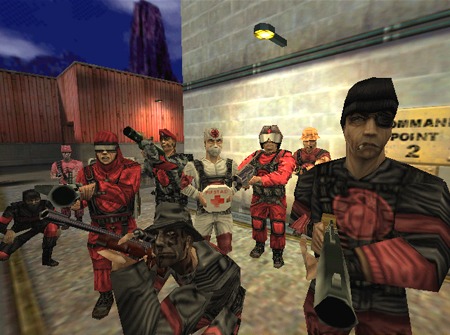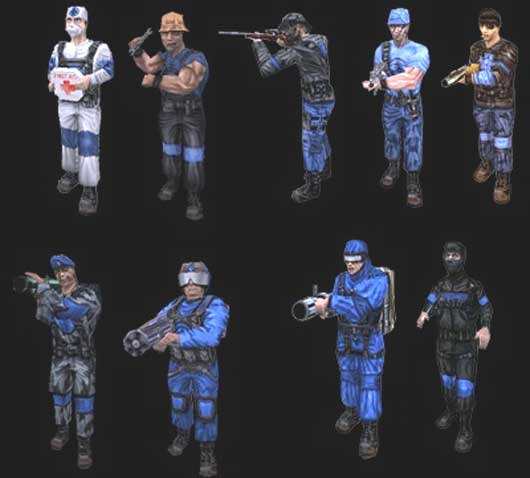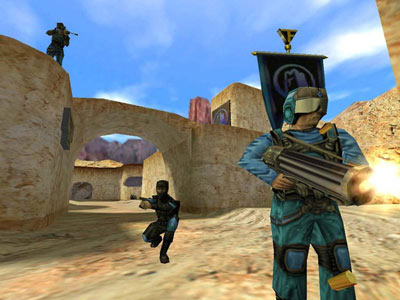
Team Fortress Classic
When one looks back at Team Fortress Classic, the most noticeable element is that the game is more in line with a traditional military-based shooter, as opposed to the colourful, hat-simulating sequel we play today. However, while it may not be as charming as today’s releases, it more than holds it own based on mechanics alone.
So let’s take a moment and trace the history of this game, which serves as one of the most persistently successful Half Life and Quake mods of all time.

As a brief intro, Team Fortress started its life as a Quake mod in 1996, and was designed by Robin Walker, John Cook and Ian Caughley. The game proved extremely popular with players, leading to the eventual idea that a stand alone Team Fortress game would be created. As the designers began working on the development, and promotion, of the game, Valve Software (known for their 1997 hit, Half Life), hired the team to make the sequel for them. Before development of the sequel began, however, the team ported their mod over to the Half Life engine (which was a heavily modified Quake engine), and in 1999, Team Fortress Classic was released.
Historically, Team Fortress is perhaps one of the most enduring and influential games of all time, and I am not just saying that for dramatic effect. Let’s look at many of the firsts that Team Fortress managed to achieve.
 Primarily, Team Fortress ushered in the era of the class-based shooter. Previously, when one partook in a multiplayer deathmatch, or team deathmatch, the differences between your characters were cosmetic at best. Sure some people were red, and some were blue, but there was very little to differentiate between you and anyone else. You were, after all, just running around firing the same weapons as your enemies and teammates.
Primarily, Team Fortress ushered in the era of the class-based shooter. Previously, when one partook in a multiplayer deathmatch, or team deathmatch, the differences between your characters were cosmetic at best. Sure some people were red, and some were blue, but there was very little to differentiate between you and anyone else. You were, after all, just running around firing the same weapons as your enemies and teammates.
Team Fortress, however, presented the idea that each team would be made up of unique characters, each with their own unique abilities. While this idea had been popular in genres such as the RPG or strategy game, it had never really been attempted in terms of the first person shooter. Thus the idea of having a dedicated medic, soldier, sniper, etc. was a new and exciting gamble. And boy, did that gamble pay off. Team Fortress Classic was, in its early life, the second most played online game, second only to Counter Strike (another Half Life mod).
The ability to play as different classes provided an opportunity for expanded replayability. While a traditional FPS game essentially follows the same gameplay routine of getting a gun and running around shooting as quickly as possible, Team Fortress allowed you to do much more. All of a sudden you could play as a spy, who had the ability to disguise oneself as a member of the enemy team, thus allowing stealth kills. If you got tired of sneaking around, you could play as the defensively focused engineer, who has the ability to build turrets and defends one flag. It was this variety of play style within the game which kept bringing people back. And it is a variety that class-based games such as Call of Duty, Battlefield, etc. owe a debt too.
By allowing different class types, the game also allowed a personification of oneself within a first person shooter. An allegiance to specific classes by players was, and still is, a common occurrence in the world of online gaming. People will spend hours online debating the merits of each class, or simply come together to revel in the fact that being a spy kicks ass.
People will spend hours online debating the merits of each class, or simply come together to revel in the fact that being a spy kicks ass.
It should also be noted that the game heralded the first appearance of the head shot. Yes, Team Fortress, an independently release mod, was the first to ever include the headshot in a first person shooter. So next time you hear “boom headshot,” you have Team Fortress to thank.
Overall, Team Fortress was, and is, a tour de force. While aesthetically it does not resemble the Team Fortress we are used to today, it is the defining blueprint for multiplayer-focused first person shooters that came after it. While Doom and Quake may have perfected the chaos that is first-person shooter, Team Fortress refined and transformed this chaos into an art. Go on and give it a download, you can still find it on Steam today.